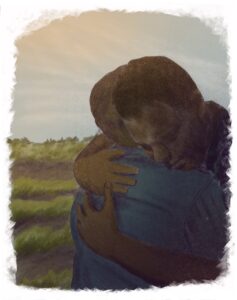
Episode 1: Fry Bread
featuring
Chef Nico Albert Williams
Episode premieres May 17th
Welcome to Rural Food Traditions, a podcast series of Rural Remix. We’re starting where many meals across diverse food traditions begin: with bread. Food is a uniter; and across culinary traditions, bread is a common thread. On this episode, host Teresa Collins talks with chef Nico Albert Williams about fry bread. They discuss the bread’s Native American roots, controversial history, and Nico’s personal relationship to the language of food. Below we’re sharing an excerpt from the interview, show notes, and Nico’s fry bread recipe!

Nico Albert Williams (ᏣᎳᎩᎯ ᎠᏰᎵ Cherokee Nation) is a chef, caterer and student of traditional Indigenous cuisines based in Tulsa, Oklahoma. Nico is the Executive Chef behind the catering services offered by Burning Cedar Sovereign Kitchen. Her work centers on the revitalization of ancestral Indigenous foodways to promote healing and wellness in the Native American community. She began her culinary education growing up in California and Arizona, spending time in her mother’s garden and in the kitchen preparing family meals.
An edited excerpt from the full interview with Nico. Here, Nico and Teresa discuss how fry bread became a beloved yet historically complex dish.
Nico Albert Williams: Fry bread kind of is a representation of our removal from our traditional food systems. It’s a direct result of that. So before contact, our ancestors were completely immersed in the natural world. They were a part of the ecosystem, and everything that they had that they subsisted on came from nature and from their relationship with the land. And so it was a very healthy lifestyle. It was an extremely diverse diet. And then when colonization happened, they were systematically removed from access to that land, and in varying degrees in different communities. I’ll speak about the Cherokee experience specifically. We were eventually forced to move to reservation land in Oklahoma along the Trail of Tears as a result of the Indian Removal Act. That meant that we no longer had access to the wide range of foods anymore. And we were put in a very small area compared to the full range of the southern Appalachians that we had access to. And we were given land that’s not necessarily meant to be farmed for our specific crops that we were used to growing, and that didn’t have the biodiversity of species that we had in Appalachia and that we had to adjust to.
And so all of those things led to this enormous disruption in food system, and eventually a reliance on the federal government for food subsidies that came in the form of commodity foods and rations. And those rations were things like bleached white flour, refined lard, refined sugar, coffee, tinned meats, preserved canned vegetables, things like that. They were designed to be shelf stable. They were designed to travel over large distances, because we weren’t the only ones receiving those foods. They were going to communities in reservations all over Indian territory and beyond.
Teresa: None of those were part of the natural diet.
Nico Albert Williams:
No. Every single ingredient that they gave us was things that our bodies had never experienced before, that were not a part of our diet.
And this was a sweeping change that happened within one or two generations. So it was a drastic change for our people to be reliant on these foods that were completely devoid of nutrition. When you compare the nutritional density to our traditional foods that we talked about, and then something like just refined sugar, lard, and bleached flour, it does not offer the body anything other than to quell hunger. And it fills your stomach, but it doesn’t fill anything else.
So while that comes from a place of hardship over the generations, that food does make its way into our traditions and our families, and it becomes a beloved food. I mean, there’s no denying that deep-fried dough is delicious. Everyone agrees, and every culture has their version of a fried bread and donuts and all these different things, and they’re all delicious. They’re meant as in those other cultures, you think about donuts or beignets or something like that, that fried dough is meant as a treat or a snack. It’s not meant to be the entirety of the meal or half of the meal, but that’s where we ended up is that those foods, even though they’re very delicious, they’re not nutritious and they’re not meant to be the staple of a meal, but that’s what they ended up being because of our situation.
And so that being said, while we know that they have caused a lot of health problems in Indian country, we have a lot of health disparities, like higher rates of diabetes, higher rates of heart disease and obesity, all relating to our disruption of food systems and the introduction of those foods and the reliance on those foods like fry bread. We still form an emotional attachment to those foods. And fry bread is a beloved part of the dinner table in Cherokee families and native families all over Indian territory that all had the same experience of creating this dish as something that our ancestors made so that we could survive.
And it’s made its way along over the years to where now it’s a part of every ceremony, it’s a part of every gathering. When we get together for our celebrations throughout the year, it’s always got a place at the table because people love it, and because we’ve formed that relationship with that food over the years.

Teresa: So it seemed more as a sign of defiance and resilience.
Nico Albert Williams:
That is the way we look at it, is ingredients that were forced on us, and our ancestors had the ingenuity to take those things and make something really comforting out of it. And it does represent hardship, but it also represents resilience. And so one of the reasons that we’re here today, that I’m here today, is that my ancestors were able to survive on the very little that they were given. And so that’s the context that we try to view fry bread in.
That’s not a widespread understanding all across Indian country. That is a narrative that we are teaching, because a lot of people, the fry bread is there, but they haven’t really stopped to think about the story of how it got there and where we came from. And so that’s part of the work that we do is really to be able to communicate that to our families and our communities that we can enjoy this fry bread, but we need to know the story behind it so that we know how it came to us and what it means when we eat it. And so that we can use this as a tool to celebrate our ancestors and what they did for us, the sacrifices they made and their struggles so that we could be here today.
That’s part of the story that we need to tell when that fry bread basket makes it to the table, because otherwise we’re just consuming, and that doesn’t align with our values as indigenous people. We are not meant to consume things blindly. We need to know the story behind things and how it connects us to each other and how it connects us to our history. Everything on the dinner table needs to have that context. And at the very least, we might not be getting the physical nutrition from eating the fry bread, but it does provide us with an emotional and a mental, and in some cases a spiritual connection, because it connects us to our ancestors and their struggle.
Rural Food Traditions is a production of Rural Remix. Original music was composed by Quincy Ponvert and Leo Posel. This series was written and produced by Teresa Collins and edited by Susannah Broun. Assistant producers are Tracy Staley and Anya Slepyan. The Executive Producer is Joel Cohen. Rural Remix is a co-production of the Daily Yonder and the Rural Assembly, projects of the Center for Rural Strategies.








